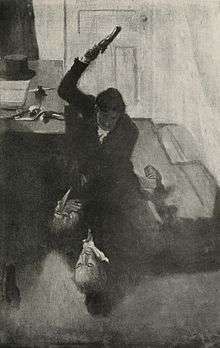Pistol-whipping

Pistol-whipping or buffaloing is the act of using a handgun as a blunt weapon, wielding it as if it were a club or baton.[1] "Pistol-whipping" and "to pistol-whip" were reported as "new words" of American speech in 1955, with cited usages from the 1940s.[2] However, both the term and the practice trace back to the Wild West of the 19th century.
Pistol-whipping should not be confused with butt-stroking, a close combat military discipline using the rifle.
Method
Paul Wellman notes that clubbing an opponent with the butt of a gun held by its barrel, as seen in some Westerns, is problematic. First, guns are designed for shooting, not as a club. Second, the danger of an unintentional discharge could fatally wound the "clubber". Additionally, many handguns, specifically revolvers, lack sufficient structural strength (particularly black powder cap and ball era revolvers). Striking a target in this manner could cause damage to the weapon. Finally, rotating a gun so that it can be held by its barrel takes extra time. The loss of time may be crucial during a fight. Instead, pistol-whipping should be done with the gun held in an ordinary manner, hitting the target with an overhand strike from either the long, heavy barrel of the gun or the side of the gun in the area of the cylinder. It was a fairly common way to incapacitate a man (assisted by the heavy weight of the handguns of the day), and was known as "buffaloing", with the verb form being "to buffalo".[3][4] This form of pistol-whipping with an 1860s-style revolver was tested on the Spike TV television show Deadliest Warrior.[5] The testers showed that using the long barrel of a Colt revolver in a whipping motion produced enough force to fracture a skull and could potentially kill a man with a single blow.
Forensics
Pistol whipping may leave unusual lacerations on the body of the injured due to various protruding details of the pistol.[6] Semicircular or triangular lacerations on the skin may be produced by the butt of a pistol. The magazine well and base produce rectangular lacerations on the skin.[7] These lacerations can vary in depth and severity, but "whipped" fractures are common.
References
- ↑ "Pistol whipping", Random House Unabridged Dictionary
- ↑ "Fifty Years Among the New Words: by John Algeo, p. 142, from vol. 30 (1955), no. 4 of the American Speech, the journal of the American Dialect Society
- ↑ The Trampling Herd: The Story of the Cattle Range in America by Paul Iselin Wellman (1988) ISBN 0-8032-9723-8, p. 196
- ↑ The True Life Wild West Memoir of a Bush-popping Cow Waddy, by Charley Hester, Kirby Ross, 2004, ISBN 0-8032-7346-0, Chapter 14: "Buffaloing"
- ↑ Deadliest Warrior, Seasion 2 Episode 3 'Jesse James vs Al Capone'
- ↑ "Pistol whipping", in Forensic Pathology, by David Dolinak, Evan W. Matshes, Emma O. Lew, 2006, ISBN 0-12-219951-0, p. 185
- ↑ "Gunshot Wounds: Practical Aspects of Firearms, Ballistics, and Forensic Techniques", Vincent J.M. DiMaio, 1999, ISBN 0-8493-8163-0, pp. 270-271